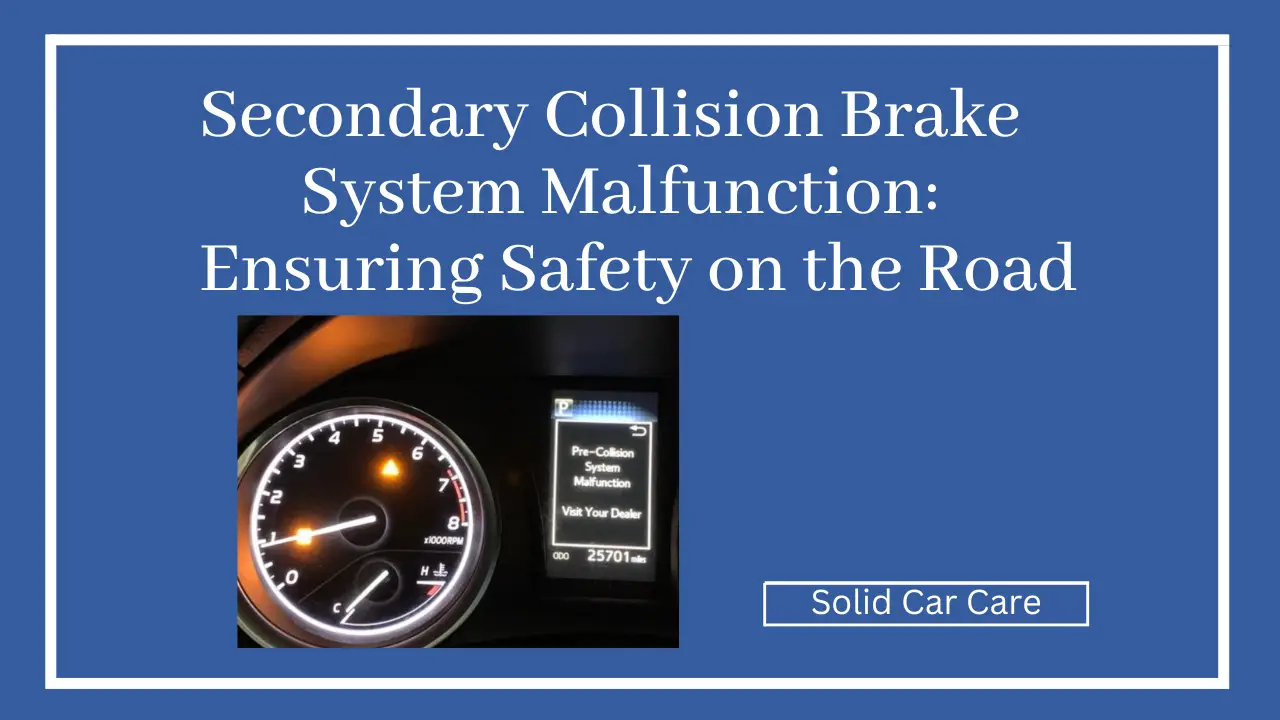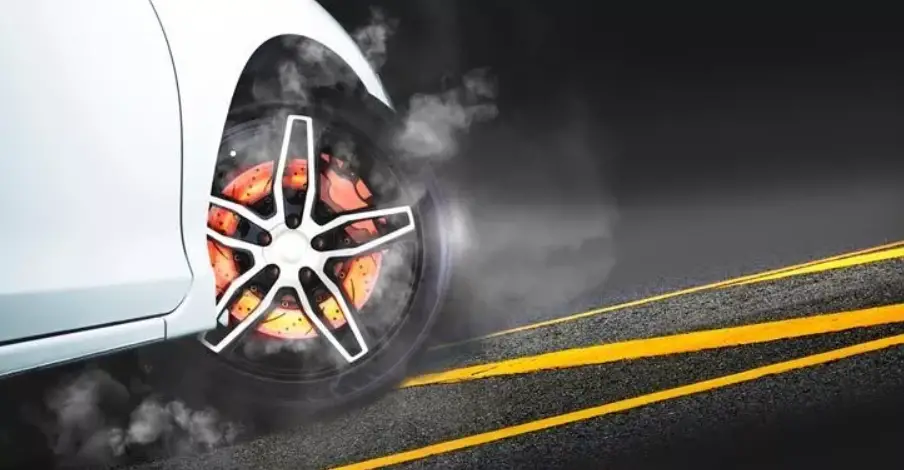Secondary Collision Brake System Malfunction: Ensuring Safety on the Road

Regarding vehicle safety, the secondary collision brake system plays a crucial role in preventing potential accidents. However, like any other system, it is not immune to malfunctions.
In this article, we will delve into the intricate details of secondary collision brake system malfunction, its causes, symptoms, risks, diagnosis, and preventive measures.
Table of Contents
What is the Secondary Collision Brake System?

The secondary collision brake system is an advanced safety feature designed to mitigate the risk of secondary collisions. This system operates independently of the driver, automatically applying brakes after an initial collision to minimize the impact of subsequent collisions. Reducing the kinetic energy transferred during secondary impacts, helps protect the occupants and mitigate property damage.
This sophisticated system comprises various components, including sensors, control units, and actuators. These components work in tandem to detect the occurrence of a primary collision and promptly activate the brakes to reduce the chances of subsequent collisions.
What are the causes of secondary collision brake system malfunctions?
Several factors can contribute to the malfunctioning of the secondary collision brake system. Understanding these causes is crucial for effectively diagnosing and resolving the issue. Common causes include:
Sensor failure
The sensors responsible for detecting primary collisions may experience malfunction due to physical damage or electrical issues. Faulty sensors can result in inaccurate or delayed detection of collisions.
Electrical issues
Problems within the electrical circuitry, such as damaged wiring or loose connections, can disrupt the communication between system components, leading to a malfunction.
Mechanical problems
Mechanical issues, such as brake caliper failure or worn-out brake pads, can interfere with the proper functioning of the secondary collision brake system, reducing its effectiveness.
Signs and Symptoms of Secondary Collision Brake System Malfunction
Identifying the signs and symptoms of a malfunctioning secondary collision brake system is crucial for prompt action and ensuring safety. Look out for the following indicators:
Warning lights and error messages
If your vehicle’s dashboard displays warning lights related to the braking system or shows error messages, it is essential to investigate further, as it may indicate a malfunction.
Unusual braking behavior
A malfunctioning secondary collision brake system may cause unusual braking behavior, such as sudden or erratic braking, even in the absence of an actual collision.
Inconsistent braking response
If you notice that the braking response is delayed, inconsistent, or weaker than usual, it could be a sign of a malfunction in the secondary collision brake system.
Potential Risks and Consequences
A malfunctioning secondary collision brake system can have severe consequences, posing risks to vehicle occupants and pedestrians. Some potential risks and consequences include:
Increased risk of secondary collisions
Without properly functioning the secondary collision brake system, the risk of subsequent collisions after an initial impact significantly increases, leading to greater damage and potential injuries.
Reduced vehicle control and stability
A malfunctioning system may compromise the overall stability and control of the vehicle, making it more challenging for the driver to maneuver and maintain control, especially in emergencies.
Safety implications for occupants and pedestrians
In the event of a secondary collision, the absence of an active secondary collision brake system may result in heightened injuries to the vehicle’s occupants and pedestrians.
Audi Parking Brake Malfunction Reset: How to Fix It
solidcarcare.com
Diagnosing Secondary Collision Brake System Malfunction
Properly diagnosing the malfunctioning system is crucial to determining the underlying issue and initiating the appropriate repairs. The following steps can help diagnose the problem effectively:
Diagnostic procedures and tools
Automotive technicians employ specialized diagnostic tools to identify the fault codes and retrieve valuable data from the secondary collision brake system’s control unit. This information assists in pinpointing the root cause of the malfunction.
Consulting professional technicians
Seeking assistance from experienced professionals is vital for accurate diagnosis. Certified technicians have the expertise and knowledge to troubleshoot and resolve complex secondary collision brake system issues.
Steps to Take When Encountering Secondary Collision Brake System Malfunction
Encountering a malfunctioning secondary collision brake system can be unnerving, but taking the following steps can help ensure safety and minimize risks:
Stay calm and focus on safety
It is essential to remain calm and composed in such situations. Safely maneuver the vehicle to a secure location away from traffic, if possible, and engage the emergency brake to prevent any unintended movement.
Follow the manufacturer’s instructions
Refer to the vehicle’s owner manual or the manufacturer’s guidelines to determine any specific instructions regarding secondary collision brake system malfunctions. Manufacturers often provide recommendations for handling such situations.
Seek professional assistance
Contact a qualified automotive service center or dealership to have the secondary collision brake system inspected and repaired by trained technicians. They possess the necessary skills and equipment to diagnose and fix the malfunction effectively.
Preventing Secondary Collision Brake System Malfunction
While malfunctions can occur, taking preventive measures can help reduce the likelihood of secondary collision brake system issues. Consider the following preventive steps:
- Regular maintenance and inspections
Adhere to the manufacturer’s recommended maintenance schedule and ensure regular secondary collision brake system inspections. Routine maintenance helps identify potential problems early on and allows for timely repairs.
- Software and firmware updates
Keep the vehicle’s software and firmware current. Manufacturers often release updates that address known issues, improve system performance, and enhance the overall safety features of the vehicle.
- Adhering to manufacturer guidelines
Follow the manufacturer’s guidelines regarding system usage and recommended driving practices. Operating the vehicle within the prescribed parameters helps maintain the optimal functioning of the secondary collision brake system.
What are the pros and cons of a secondary collision brake system?

Pros of Secondary Collision Brake System
- Enhanced Safety
The primary advantage of a secondary collision brake system is its ability to enhance safety on the road. By automatically applying the brakes after an initial collision, it helps reduce the impact of subsequent collisions, minimizing the risk of injuries to occupants and property damage.
- Mitigation of Secondary Collisions
Secondary collisions often occur immediately after an initial impact and can be particularly dangerous. The secondary collision brake system helps mitigate these secondary collisions by reducing the kinetic energy transferred during subsequent impacts.
- Driver-Independent Operation
The secondary collision brake system operates independently of the driver. This means that even if the driver cannot react quickly or properly apply the brakes, the system can still engage and reduce the severity of secondary collisions.
- Rapid Response Time
The system is designed to have a fast response time, detecting a primary collision and activating the brakes promptly. This swift response can significantly reduce the chances of secondary collisions and improve overall safety.
Cons of Secondary Collision Brake System:
- System Limitations
While the secondary collision brake system is an advanced safety feature, it has certain limitations. It may not be able to prevent all secondary collisions or completely eliminate the risk of injuries. The system’s effectiveness can vary depending on the specific circumstances and severity of the collisions.
- Reliance on Sensors and Technology
The proper functioning of the secondary collision brake system relies on accurate sensor data and complex technological components. If any of these components experience malfunction or damage, it can affect the system’s performance and lead to potential issues.
- False Activations
Sometimes, the secondary collision brake system may activate unnecessarily, mistaking non-collision events or objects as primary collisions. These false activations can cause abrupt braking and potentially lead to hazardous situations on the road.
- Maintenance and Repair Costs
Like any other advanced safety system, maintaining and repairing the secondary collision brake system can involve higher costs than traditional braking systems. Diagnostic procedures, specialized tools, and skilled technicians may be required to diagnose and resolve malfunctions or issues.
It’s important to note that the pros and cons can vary between different vehicle models and manufacturers. It is recommended to refer to the specific vehicle’s documentation and consult with professionals for detailed information on the advantages and limitations of a particular vehicle’s secondary collision brake system.
New Brakes Making Rubbing Noise; Why?
solidcarcare.com
Conclusion
Secondary collision brake system malfunction is a critical issue that requires attention to ensure the safety of both vehicle occupants and pedestrians. By understanding the causes, symptoms, risks, diagnosis, and preventive measures associated with this malfunction, individuals can take the necessary steps to address the issue promptly. Remember, seeking professional assistance and adhering to manufacturer guidelines are essential when encountering a malfunctioning secondary collision brake system, ultimately contributing to safer roads for everyone.






